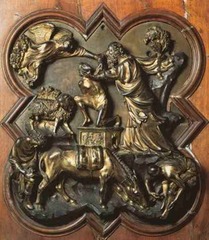
Sacrifice of Isaac
competition panel for east doors, baptistery of Florence Cathedral, Florence, Itay
Period: Renaissance
clear imagery-gothic framing
divided into horizontal and vertical axis
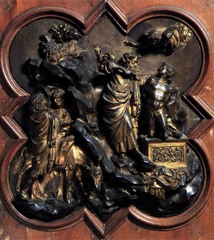
Sacrifice of Isaac
competition panel for east doors, baptistery of Florence Cathedral, Florence, Italy,
Gilded bronze relief
Period: Renaissance
Graceful poses
classical influences-form of Isaac
use of landscape
S curve movement throughout piece

dome of Florence Cathedral
Florence, Italy
Period: Renaissance
elongates dome shape to pointed dome
has gothic architectural features
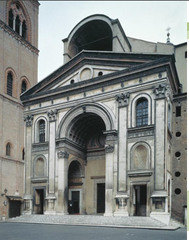
west façade of Sant’ Andrea
Mantua, Italy
Period: Renaissance

David
Bronze
Period: Renaissance
David-symbol of independent florence
first free standing nude since antiquity
feminine and youthful pose
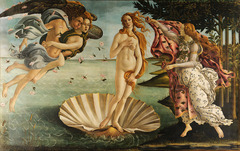
Birth of Venus
Tempera on Canvas
Period: Renaissance

Last Supper
Refectory, monastery of Sant-Apollonia, Florence, Italy
like 1st style Roman Paintings
elaborate
architectural perspective-space

Christ Delivering the Keys of the Kingdom to Saint peter
Sistine Chapel, Vatican, Rome, Italy
period: Renaissance
lines converge at the doorway of central building
deep architectural perspective
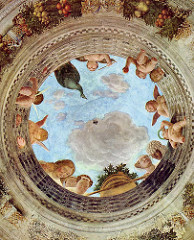
interior of the Camera degli Sposi
Palazzo Ducale, Mantua, Italy
Period: Renaissance
paint looks real
wanted to create a splendid palace
lavish and overt reference to the rule at Mantua itself

Annunciation
Period: Renaissance
wonderful bizzare facial expression and hand gesture
Angel wing showed different depiction of colorful wings
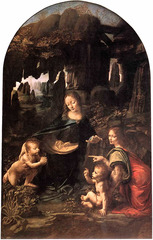
Virgin of the Rocks
Period: Renaissance
Basic Pyramidal composition
demonstrates his interest in geology and botany

Last Supper
Period: Renaissance
Not true fresco
table serves as a barrier
Painted in an area where people eat in a monastery to share this moment with christ
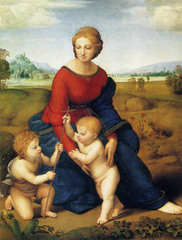
Madonna in the Meadow
Period: Renaissance
soft modeling of figure
embodies harmony and grace of figures
vibrant colors

Philosophy (School of Athens), Stanza della Segnatura, Vatican Palace, Rome Italy
Period: Renaissance
Humanism, Religion and Philosophy connected together
includes famous philosophers

Buonarroti, David
period: Renaissance
meant to be on top of the Duormo
represents the republic of florence
natural and relaxed referencing the statuary of Hercules
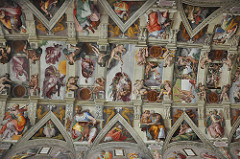
ceiling of the Sistine Chapel
Vatican City, Rome, Italy
Period: Renaissance
view of human kind in reverse

Last Judgment
altar wall of the Sistine Chapel
Period: Renaissance
Darker subject and colors
Christ is judging souls
interest in muscular forms
interest of human experience and physical forms
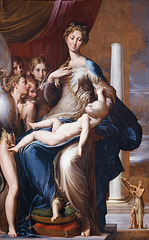
Madonna of the Long Neck
Period: Mannerism
lack of rational perspective
compared to michelangelo’s pieta
elongated forms and abstractions
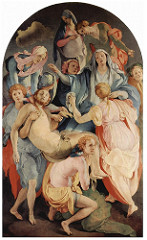
Descent from the Cross
Period: Mannerism
playing with viewer expectations-no cross or tomb
central void where the cross should be
bizzare configuration of figures in composition
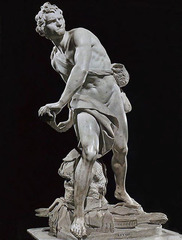
David
Galleria Borghese, Rome
Marble
Period: Baroque
moment in action
violent, pivotal moment caught in sculpture
necessary to walk around object
connection to roman disc thrower
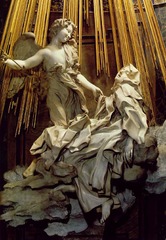
Ecstasy of Saint Teresa
Cornaro Chapel, Santa Maria della Vittoria
Rome, Itay
Period: Baroque
distinction in texture-skin, wings, fabric,clouds
chiaroscuro in sculpture
not suppose to walk around sculpture
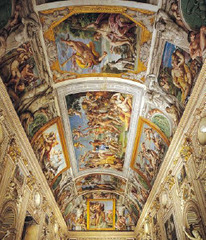
Loves of the Gods
ceiling frescoes in the gallery
Palazzo Farnese, Rome Italy
Period: Baroque
meant to be appropriate so that lay people can read it
creating naturalism close to Raphael ( ideal and perfect)
altar piece
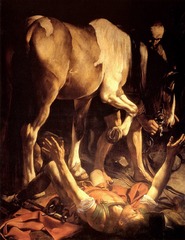
Conversion of Saint Paul
Cerasi Chapel, Santa Maria del Popolo
Rome, Italy
period: Baroque
different form of naturalism
dramatic use of chiarscuro
increased contrast between light and dark-tenebrism

Judith slaying Holofernes
Period: Baroque
depiction of biblical slaying
story of female heroine

Judith slaying Holofernes
Period: Baroque
same depiction of caravaggio’s
more realistic and from the point of view of a woman
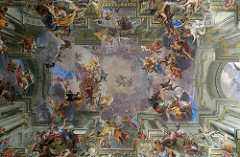
Glorification of Saint Ignatius
ceiling fresco in the nave of Sant’ Ignazio
Rome, Italy
Period: Baroque
created illusion of church going into the sky

Aurora
period: Baroque
represents Aurora bringing on a new day
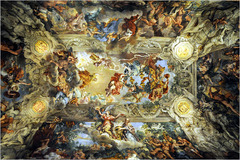
Allegory of Divine Providence and Barberini Power,
Period: Baroque
Optical illusion of sky
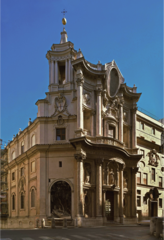
façade of San Carlo alle Quattro Fontane
Rome, Italy
period: Baroque
Façade-distinctly baroque
created something not flat
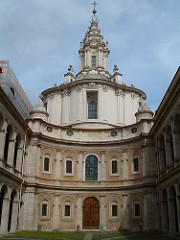
Borromini, Sant’lvo della Sapienza
period: Baroque
not static classical elements used in a different way
Best known Italian Renaissance art patrons were the Medici family
movements (artistic and intellectual) marked the early Southern Renaissance in
Florence? What artists were prominent at that time? How did the political
structure influence both patronage and the subject matter of Florentine art in
the 15th century?





